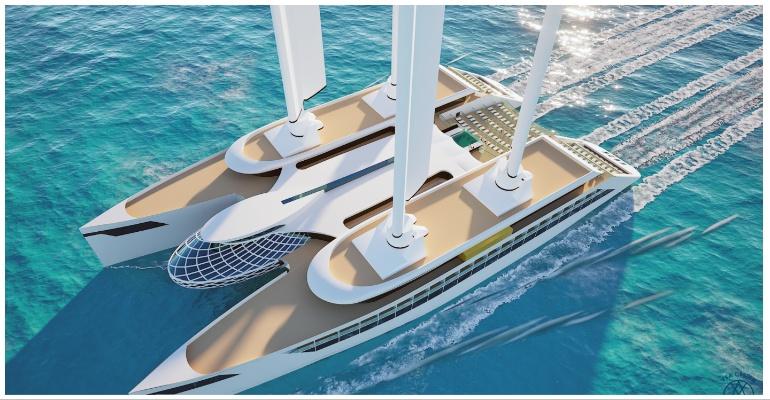The 104.5mtr dual-hull vessel would have capacity for 200 guests.
Using a market-ready solution, four 50mtr high foldable sails would be mounted on 6mtr high bases on deck to capture zero emission wind. In case of insufficient wind, engines would run on green bio-methanol although the ship would also be enabled with a hybrid drive to incorporate silent running on battery power.
Sustainable design
Two 18.2mtr wide hulls would be connected by an inverted U-shaped structure spanning 18.5mtr, with the cat’s two-deck central superstructure incorporating the bridge and some public spaces. Each hull would include four decks plus a ‘yacht top’, with room for 100 dual occupancy guest cabins and 155 crew.
Trond Sigurdsen, senior architect and partner, YSA Design, revealed the new concept during a Design Spotlight panel Wednesday at the Seatrade Global Cruise conference in Miami. ‘Sustainability is critical but cruise shipping also needs to continuously reinvent itself. A sustainable ship which brings environmentally conscious guests closer to the sea and reaches destinations others cannot is a clear opportunity for premium cruising.’
With hulls featuring retractable aft and central platforms extending down to the water when Seabreeze is at anchor or in dynamic positioning mode, sea lounges could then open up for sunset dining, as spas, or as beach and watersports clubs.
The design envisages a transparent bay structure between the hulls so that guests can ‘hover’ over the sea. Enhanced by auxiliary lighting, ‘seeing a shipwreck or coral reef would be unforgettable,’ said Sigurdsen. In another scenario, guests relax on a mesh net connecting the hulls.
‘Seabreeze also aligns closely with contemporary thinking on destination-based cruising, where a ship gliding in under sail would not disturb wildlife and would be a welcome visitor anywhere. A 21st century wind-powered ship could even drive revival in communities which suffered with the demise of sail,’ commented Sigurdsen.
Copyright © 2024. All rights reserved. Seatrade, a trading name of Informa Markets (UK) Limited.
Add Seatrade Cruise News to your Google News feed.  |

